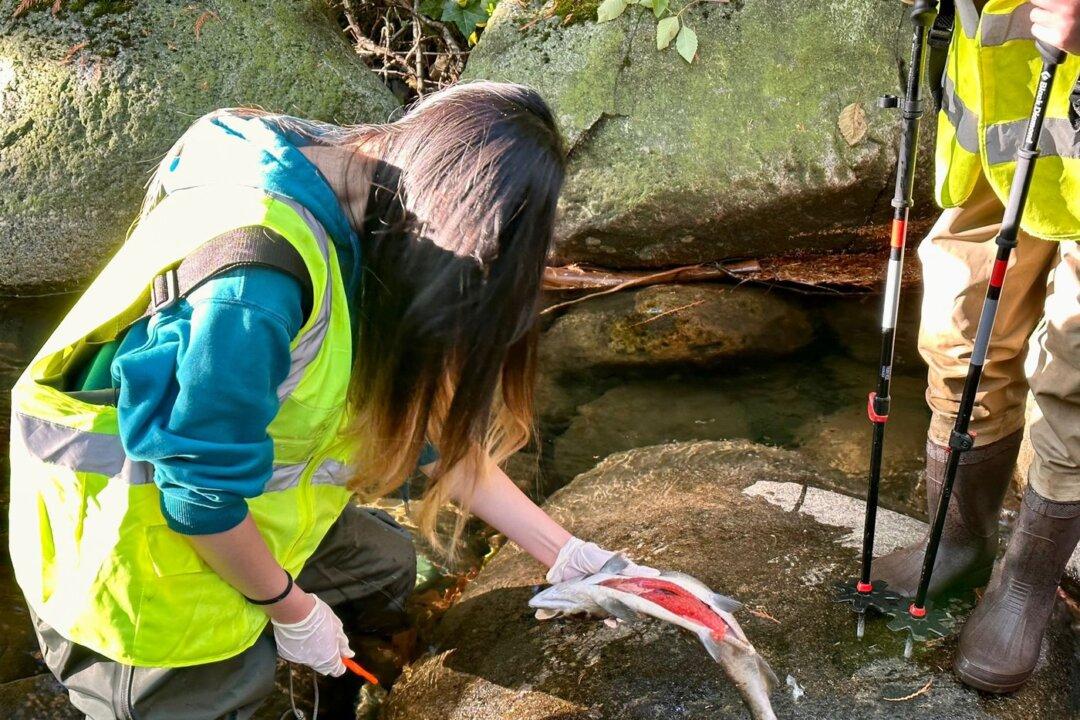John Barker has been volunteering with the West Vancouver Streamkeeper Society for more than 20 years and says he’s never seen anything like it, dozens of coho salmon, pre-spawn and silvery, looking fresh from the sea, dead at the mouth of Brothers Creek.
“When you have a loss like this, it’s devastating,” said Mr. Barker.
He and others suspect the culprit in the “unprecedented” kill in late October could have been a chemical found in tires that has previously been associated with coho deaths, coupled with B.C.’s drought.
He hopes solutions can be found and wants the tire industry to find an alternative to the chemical, called 6PPD-quinone.
“Some people seem to think water that’s picked up off the street is going to a treatment plant. Well, it’s not,” said Mr. Barker.
“It’s being deposited straight into the watercourses. If you’ve got hostile product on the roadside and it gets picked up, that’s where it’s going to go,” said Mr. Barker. “We’ve seen that firsthand now.”
The society said in a statement that lack of rain may have allowed the chemical to build up on roads before late rains in the fall flushed it into waterways, where low water levels in streams further concentrated the material when the coho arrived.
The chemical, which helps tires last longer but is activated as a toxin by sunlight, is deadly to coho, and does not effect pink or chum salmon, said the statement.
Mr. Barker said he had examined six of the dead coho himself, three males and three females. None of the females had spawned, with their roe sacks still intact
Mr. Barker said the society had given samples of the dead fish to the Fisheries Department Canada for analysis. He said he was told by the department that there was a “strong possibility” that 6PPD-quinone played a role in the deaths.
A study by researchers in Washington state published in 2020 found that 6PPD-quinone was the likely cause of death of coho returning to urban streams and rivers in Puget Sound.
Tanya Brown, a research scientist for the fisheries department at the Pacific Science Enterprise Centre in West Vancouver, said her team has been testing Brothers Creek for 6PPD-quinone before, during, and after rain events.
She said they don’t have results yet as her lab is still running samples.
However, Ms. Brown said her team has also been monitoring 70 creeks across Metro Vancouver over the past 2 1/2 years, and they are have been seeing 6PPD-quinone in lethal concentrations during rain events.
Ms. Brown said various salmon species respond differently to 6PPD-quinone, and many research groups, including her lab, are investigating why coho are more vulnerable.
Mr. Barker said he hopes strategies will be introduced to mitigate the risks, such as using filtration to help purify run-off.
But in the long run, Mr. Barker said the tire industry had to come up with a different chemical.
Ms. Brown said it would take decades before 6PPD-quinone could be eliminated from tires.
Michal Majernik, spokesman for the Tire and Rubber Association of Canada, said in a statement he industry has sponsored research on 6PPD-quinone since 2020.
“The industry is currently assessing potential suitable alternatives to 6PPD in the state of California,” read the statement.
But Mr. Majernik said it’s not a simple process to change the composition of tires, and any change could affect safety and performance.
He said other strategies could include treating storm water and car owners maintaining proper tire inflation to reduce the release of the chemical.
The society said the danger seems to be over now with a good number of healthy coho recently arriving in creeks.
Mr. Barker said he was relieved to see quite a few coho arriving “in good shape” and all looking healthy in November.
He said he hopes the Brothers Creek coho kill opens people’s eyes to the problem.
“Hopefully, there are enough people that care, that will start to affect change and improve this,” said Mr. Barker.







